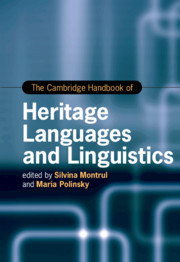Book contents
- The Cambridge Handbook of Heritage Languages and Linguistics
- Cambridge Handbooks In Language And Linguistics
- The Cambridge Handbook of Heritage Languages and Linguistics
- Copyright page
- Dedication
- Contents
- Figures and Tables
- Contributors
- Acknowledgments
- Introduction
- Part I Heritage Languages around the World
- Part II Research Approaches to Heritage Languages
- Part III Grammatical Aspects of Heritage Languages
- Part IV Heritage Language Education
- 29 Elementary School Heritage Language Educational Options and Outcomes
- 30 Community-Organized Heritage Language Programs
- 31 Curricular and Programmatic Language Development Opportunities for University-Level Heritage Language Learners
- 32 Instructed Heritage Language Acquisition
- 33 Issues and Practices in Community-Based Experiential Learning for Heritage Speakers in the United States
- 34 Developing Spanish Heritage Language Biliteracy
- 35 Heritage Language Assessment
- 36 Embracing Opportunity in Heritage Language Revitalization
- 37 Heritage Language Planning and Policy
- Index
- References
32 - Instructed Heritage Language Acquisition
from Part IV - Heritage Language Education
Published online by Cambridge University Press: 04 November 2021
- The Cambridge Handbook of Heritage Languages and Linguistics
- Cambridge Handbooks In Language And Linguistics
- The Cambridge Handbook of Heritage Languages and Linguistics
- Copyright page
- Dedication
- Contents
- Figures and Tables
- Contributors
- Acknowledgments
- Introduction
- Part I Heritage Languages around the World
- Part II Research Approaches to Heritage Languages
- Part III Grammatical Aspects of Heritage Languages
- Part IV Heritage Language Education
- 29 Elementary School Heritage Language Educational Options and Outcomes
- 30 Community-Organized Heritage Language Programs
- 31 Curricular and Programmatic Language Development Opportunities for University-Level Heritage Language Learners
- 32 Instructed Heritage Language Acquisition
- 33 Issues and Practices in Community-Based Experiential Learning for Heritage Speakers in the United States
- 34 Developing Spanish Heritage Language Biliteracy
- 35 Heritage Language Assessment
- 36 Embracing Opportunity in Heritage Language Revitalization
- 37 Heritage Language Planning and Policy
- Index
- References
Summary
This chapter begins by highlighting the findings of recent narrative reviews on outcomes of instructed heritage language acquisition. Further, it describes the advantages of quantitative meta-analysis, which has proven to be an effective research synthesis method to identify patterns in study findings and to determine under-investigated variables. The bulk of the chapter is devoted to a description of an exploratory quantitative meta-analysis of the research on instructed heritage language acquisition to date. The grand weighted effect size for the over-arching question, “What impact does heritage language instruction have on heritage language ability?” was d =.57, indicating that heritage language instruction has a moderate, positive effect on heritage language development. The need for more detailed reporting, echoing similar calls in second language acquisition, is emphasized; attention to variables identified by the meta-analysis as under-studied are drawn; and a call is made to conduct longitudinal studies in order to trace the impact of instruction beyond the short term. The conclusion stresses recommendations for multi-site research and replication, a strategy that will help to move the field forward, especially in heritage languages with smaller populations of speakers or speaker populations that are geographically dispersed.
Keywords
- Type
- Chapter
- Information
- The Cambridge Handbook of Heritage Languages and Linguistics , pp. 826 - 850Publisher: Cambridge University PressPrint publication year: 2021
References
- 4
- Cited by

